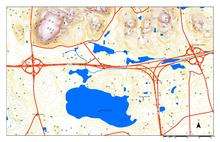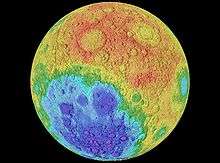Hypsometric tints
Hypsometric tints are colors used to indicate elevation, usually together with contour lines. They can be used to depict ranges of elevation as bands of color, usually in a graduated scheme, or as a color ramp applied to contour lines themselves. A typical scheme progresses from dark greens for lower elevations up through yellows/browns, and on to grays and white at the highest elevations. Hypsometric tinting of maps and globes is often accompanied by a similar method of bathymetric tinting to convey depth of oceans; lighter shades of blue represent shallower water such as the continental shelf and darker shades deeper regions.

History
In his map of central Italy, c.1503, Leonardo da Vinci introduced the cartographic convention of using color to indicate changes in elevation.[1][2]

The Scottish map firm John Bartholomew and Son is credited with popularizing the technique, and its color scheme has become conventional: dark greens at low elevations, progressing through yellows and ochers, to browns and then grays and white at the highest elevations.
At right is "The very earliest rendition of a bathymetric map of an oceanic basin. Matthew Fontaine Maury published this map in 1853 in Explanations and Sailing Directions to Accompany the Wind and Current Charts."[3]
Uses


Similar to false-color imagery, hypsometric tints can be used to make geographic information more accessible, as with this image of lunar topography.
Some cartographers have suggested that hypsometric tints are often used as decoration, rather than for informational purposes:[4]
…the current popularity of hypsometric tints has more to do with production ease and pretty colors than it does with our interest in elevation. … With hypsometric tints, the end result is often a map with pleasing colors that blend softly into one another in an orderly fashion, a design trait that people find attractive, even if they don’t necessarily know or care about elevations.
References
- ↑ Royal Collection - A map of central Italy (Leonardo da Vinci)
- ↑ Claim of da Vinci's first use
- ↑ NOAA Ocean Explorer: First bathymetric map printed
- ↑ Patterson, T. and Vaughn Kelso, K. (2004). Hal Shelton Revisited: Designing and Producing Natural-Color Maps with Satellite Land Cover Data. Cartographic Perspectives, 47. p. 9